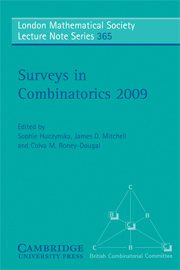Book contents
- Frontmatter
- Contents
- Preface
- 1 Graph decompositions and symmetry
- 2 Combinatorics of optimal designs
- 3 Regularity and the spectra of graphs
- 4 Trades and t-designs
- 5 Extremal graph packing problems: Ore-type versus Dirac-type
- 6 Embedding large subgraphs into dense graphs
- 7 Counting planar graphs and related families of graphs
- 8 Metrics for sparse graphs
- 9 Recent results on chromatic and flow roots of graphs and matroids
6 - Embedding large subgraphs into dense graphs
Published online by Cambridge University Press: 05 May 2013
- Frontmatter
- Contents
- Preface
- 1 Graph decompositions and symmetry
- 2 Combinatorics of optimal designs
- 3 Regularity and the spectra of graphs
- 4 Trades and t-designs
- 5 Extremal graph packing problems: Ore-type versus Dirac-type
- 6 Embedding large subgraphs into dense graphs
- 7 Counting planar graphs and related families of graphs
- 8 Metrics for sparse graphs
- 9 Recent results on chromatic and flow roots of graphs and matroids
Summary
Abstract
What conditions ensure that a graph G contains some given spanning subgraph H? The most famous examples of results of this kind are probably Dirac's theorem on Hamilton cycles and Tutte's theorem on perfect matchings. Perfect matchings are generalized by perfect F-packings, where instead of covering all the vertices of G by disjoint edges, we want to cover G by disjoint copies of a (small) graph F. It is unlikely that there is a characterization of all graphs G which contain a perfect F-packing, so as in the case of Dirac's theorem it makes sense to study conditions on the minimum degree of G which guarantee a perfect F-packing.
The Regularity Lemma of Szemerédi and the Blow-up Lemma of Komlós, Sárközy and Szemerédi have proved to be powerful tools in attacking such problems and quite recently, several long-standing problems and conjectures in the area have been solved using these. In this survey, we give an outline of recent progress (with our main emphasis on F-packings, Hamiltonicity problems and tree embeddings) and describe some of the methods involved.
Introduction, overview and basic notation
In this survey, we study the question of when a graph G contains some given large or spanning graph H as a subgraph. Many important problems can be phrased in this way: one example is Dirac's theorem, which states that every graph G on n ≥ 3 vertices with minimum degree at least n/2 contains a Hamilton cycle.
- Type
- Chapter
- Information
- Surveys in Combinatorics 2009 , pp. 137 - 168Publisher: Cambridge University PressPrint publication year: 2009
- 21
- Cited by



